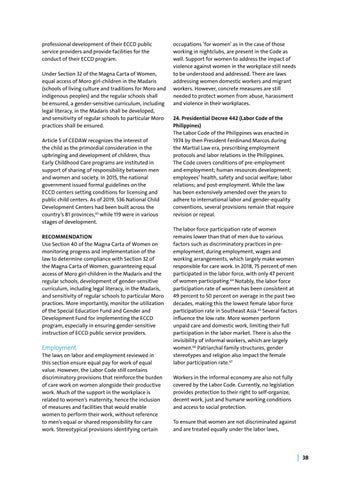professional development of their ECCD public service providers and provide facilities for the conduct of their ECCD program. Under Section 32 of the Magna Carta of Women, equal access of Moro girl-children in the Madaris (schools of living culture and traditions for Moro and indigenous peoples) and the regular schools shall be ensured, a gender-sensitive curriculum, including legal literacy, in the Madaris shall be developed, and sensitivity of regular schools to particular Moro practices shall be ensured. Article 5 of CEDAW recognizes the interest of the child as the primordial consideration in the upbringing and development of children, thus Early Childhood Care programs are instituted in support of sharing of responsibility between men and women and society. In 2015, the national government issued formal guidelines on the ECCD centers setting conditions for licensing and public child centers. As of 2019, 536 National Child Development Centers had been built across the country’s 81 provinces,63 while 119 were in various stages of development. RECOMMENDATION Use Section 40 of the Magna Carta of Women on monitoring progress and implementation of the law to determine compliance with Section 32 of the Magna Carta of Women, guaranteeing equal access of Moro girl-children in the Madaris and the regular schools, development of gender-sensitive curriculum, including legal literacy, in the Madaris, and sensitivity of regular schools to particular Moro practices. More importantly, monitor the utilization of the Special Education Fund and Gender and Development Fund for implementing the ECCD program, especially in ensuring gender-sensitive instruction of ECCD public service providers.
Employment The laws on labor and employment reviewed in this section ensure equal pay for work of equal value. However, the Labor Code still contains discriminatory provisions that reinforce the burden of care work on women alongside their productive work. Much of the support in the workplace is related to women’s maternity, hence the inclusion of measures and facilities that would enable women to perform their work, without reference to men’s equal or shared responsibility for care work. Stereotypical provisions identifying certain
occupations ‘for women’ as in the case of those working in nightclubs, are present in the Code as well. Support for women to address the impact of violence against women in the workplace still needs to be understood and addressed. There are laws addressing women domestic workers and migrant workers. However, concrete measures are still needed to protect women from abuse, harassment and violence in their workplaces. 24. Presidential Decree 442 (Labor Code of the Philippines) The Labor Code of the Philippines was enacted in 1974 by then President Ferdinand Marcos during the Martial Law era, prescribing employment protocols and labor relations in the Philippines. The Code covers conditions of pre-employment and employment; human resources development; employees’ health, safety and social welfare; labor relations; and post-employment. While the law has been extensively amended over the years to adhere to international labor and gender-equality conventions, several provisions remain that require revision or repeal. The labor force participation rate of women remains lower than that of men due to various factors such as discriminatory practices in preemployment, during employment, wages and working arrangements, which largely make women responsible for care work. In 2018, 75 percent of men participated in the labor force, with only 47 percent of women participating.64 Notably, the labor force participation rate of women has been consistent at 49 percent to 50 percent on average in the past two decades, making this the lowest female labor force participation rate in Southeast Asia.65 Several factors influence the low rate. More women perform unpaid care and domestic work, limiting their full participation in the labor market. There is also the invisibility of informal workers, which are largely women.66 Patriarchal family structures, gender stereotypes and religion also impact the female labor participation rate.67 Workers in the informal economy are also not fully covered by the Labor Code. Currently, no legislation provides protection to their right to self-organize, decent work, just and humane working conditions and access to social protection. To ensure that women are not discriminated against and are treated equally under the labor laws,
| 38

